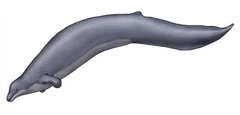| Basilosaurus | |
|---|---|

| |
| An artist's interpretation of Basilosaurus cetoides. Note the absence of a fluke on it's tail. | |
| Scientific classification | |
| Kingdom: | Animalia |
| Phylum: | Chordata |
| Class: | Mammalia |
| Order: | Cetacea |
| Suborder: | †Archaeoceti |
| Family: | †Basilosauridae |
| Subfamily: | †Basilosaurinae Cope, 1868 |
| Genus: | †Basilosaurus Harlan 1834 |
| Referred species | |
| |
| Synonyms | |
| |
Basilosaurus was a carnivorous, prehistoric cetacean that lived 40-35 million years ago in the Eocene epoch.
The head of Basilosaurus did not have room for a melon like modern day toothed whales, and the brain was smaller in comparison as well. It is believed that they therefore did not have the social capabilities of modern whales. The skull of Basilosaurus is asymmetrical like in modern toothed whales, and not, as previously assumed, symmetrical like in baleen whales and artiodactyls closely related to cetaceans. In modern toothed whale this asymmetry is associated with high-frequency sound production and echolocation, neither of which is thought to be present in Basilosaurus. This cranial torsion probably evolved in protocetids and basilosaurids together with directional underwater hearing and the sound receiving apparatus in the mandible (the auditory fat pad and the pan bone (thin portion of mandible). In the basilosaur skull, the inner and middle ear are enclosed by a dense tympanic bulla. The synapomorphic cetacean air sinus system is partially present in basilosaurids, including the pterygoid, peribullary, maxillary, and frontal sinuses. The periotic bone, which surrounds the inner ear, is partially isolated. The mandibular canal is large and laterally flanked by a thin bony wall, the pan bone or acoustic fenestra. The basilosaurid ear has a large external auditory meatus, strongly reduced in modern cetaceans, but, even-though this was probably functional, it can have been of little use under water. No complete Basilosaurus skeleton is known, but several attempts have been made to reconstruct the vertebral column from partial skeletons. More complete fossils uncovered in Egypt in the 1990s, allowed a more accurate estimation: the vertebral column of B. isis has been reconstructed from three overlapping skeletons to a total of 70 vertebrae with a vertebral formula interpreted as 7 cervical, 18 thoracic, 20 lumbar and sacral, and 25 caudal vertebrae.
Basilosaurus has an anguilliform (eel-like) body shape because of the elongation of the centra of the thoracic through anterior caudal vertebrae. In life, these vertebrae were filled with marrow, and, because of the enlarged size, this made them buoyant. From this it can be deduced that Basilosaurus swam predominantly in two dimensions at the sea surface, in contrast to the smaller Dorudon which was probably a diving, three dimensional swimmer. The skeletal anatomy of the tail suggests that a small fluke was probably present, which would have aided only vertical motion. Most reconstructions show a small, speculative dorsal fin similar to a rorqual whale’s, but other reconstructions show a dorsal ridge. A 16 m (52 ft) individual of B. isis had 35 cm (14 in) long hindlimbs with fused tarsals and only three digits. The limited size of the limb and the absence of an articulation with the sacral vertebrae, makes a locomotory function unlikely.